Xinjiang – China’s final frontier
Xinjiang, a gargantuan province making up one fifth of the Peoples Republic of China and bordering Mongolia, Russia, Kazakhstan, Kyrgyzstan, Tajikistan, Afghanistan, Pakistan and India is seen by may foreign travellers a China’s final frontier. A piece of land that signifies the end of China and the beginning of Central Asia and the Indian Subcontinent.
Much has been written on the subject of Xinjiang, so I certainly cannot cover it in depth in such a short article. However I will do my best to give a very brief introduction. Xinjiang is very different to the rest of Chinas. The Uyghur community which makes up roughly 46% of Xinjiang’s population is culturally, linguistically and ethnically different from the Han Chinese, the most dominant of Chinas 56 ethnic groups and the second largest ethnic group in Xinjiang. Aside from this there are numerous other ethnic groups in Xinjiang making it one of Chinas most ethnically diverse regions.
Mandarin and Uyghur are the two most dominant languages in the region. Uyghur has no relation to Mandarin Chinese, it is in fact a Turkic language which is quite similar to Uzbek, Kazakh and Kyrgyz. This linguistic diversity is seen everywhere from road signs, to propaganda slogans, to receipts and even on the storefronts and boards of both small and big businesses. You may have difficulties finding English speakers amongst both the Uyghur and Han communities. Mandarin is a far more useful language to communicate with, although there are some Uyghur areas where no Mandarin is spoken at all.
When to go
Winter is cold and summer swelters. April to May and September to October are two of the best times to visit but avoid the Chinese National holidays from May 1-3 and October 1-7. During these times trains, hotels, restaurants and tourist destinations will be rammed. We visited Xinjiang for 1 week towards the end of September and the weather was fantastic and tourist numbers were low.
Where we went
Since we only spent a week in Xinjiang this is most certainly not an exhaustive guide to the region. That being said our itinerary is a good place to start for anyone heading to Xinjiang for the first time.
Day 1
Arrived in Turpan on a night train from Dunhuang in Gansu. Spent the afternoon visiting the Emin Minaret and wandering around the old houses and grape vines that surround it.
Day 2
Hired a taxi to visit Jiaohe ancient ruins and Tuyoq village nestled in the moutains.
Day 3
Explored Turpan before getting on an 18 hour train to Kashgar at 2pm.
Day 4
We’d already arranged for an overnight trip to Tashkurgan along the Karakoram Highway, so we met our driver at the train station. After getting the necessary paper work for Miranda who is a Chinese citizen we drove all the way down to Tashkurgan.
Day 5
We left Tashkurgan at 9:30 and got into Kashgar at around 5pm.
Day 6
Luckily this was a Sunday so we were lucky enough to be able to visit the livestock market in the north west of the city.
Day 7
We explored Kashgar’s old town visiting as well as visiting the Apak Khoja Masuoleum and the Id Kah Mosque.
Day 8
Back to Beijing
Getting to Xinjiang
Xinjiang is easily accessible by train and plane within China, with most major cities having direct flights to the provincial capital Urumqi. For anywhere else in Xinjiang train is by far the best bet, especially now that a new high speed line has opened between Urumqi and Turpan lowering the journey time between the two to 90 minutes. For international visitors it is unlikely there will be direct flights in to Urumqi meaning you would need to fly into China and transfer.
Getting around Xinjiang
Making up 1/5th of China, Xinjiang is massive. The best way to get around Xinjiang is by train. Although there are regular flights from Urumqi to a number of major destinations, trains are more reliable, cheaper and far more regular. Don’t forget that you can only buy tickets 60 days in advance.
Security
An area that has seen numerous riots and violent protests, underground political groups calling for an independent state of East Turkestan, large numbers joining IS in Syria and a violent underground militancy that has lasted for decades and resulted in the deaths hundreds. When considering these factors, along with the fact that you’re in China, it is not surprising that security in Xinjiang is tight. Wether you agree with it or not from a moral stand point, it is something that the you need to expect and accept because it is something that makes up a part of any visit to Chinas most restive province.
There is a heavy police presence all over Xinjiang, especially inside cities and towns. However all of police officers and security forces were polite and courteous, oddly it didn’t feel as oppressive and overwhelming as some other travel blogs have made it out to be. However living in Beijing which has security checks at every subway station and soldiers throughout the city during any government meeting means that we’re used to having a large security presence on a daily basis. Alongside this, your passport is necessary to get a lot of stuff done in China, including getting stuff done in the bank, going to the hospital, boarding a train and staying in a hotel. Basically people needing to see your passport is not hugely surprising.
What is noticeably different in Xinjiang is the amount of razor-wire, metal barriers and security cameras you will see. Almost every wall and fence is topped with razor-wire and entrances to petrol stations, government and police buildings as well as hotels are blocked by large metal barriers. In Kashgar and Turpan, the two cities we visited security cameras were numerous, to the point that your entire day could easily be put together.
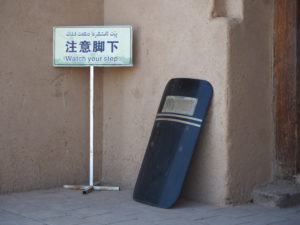
Always keep a copy of your passport on you police officers on the street may ask to see it (although this didn’t happen to us) and you will be required to present it when going through any road checkpoint, which are numerous, especially on the Karakoram Highway.
Turpan (吐鲁番)
As records go this is both the hottest and lowest point (second lowest in the world) in China. Even in late September the mercury was well into the 30’s, so it’s probably best to avoid visiting in the summer months. Home to numerous ruins, great food and some fascinating Uyghur culture it is one of Xinjiang’s most important places.
Do be aware that Turpan has two train stations, Turpan North (吐鲁番北站) and Turpan (吐鲁番站). The second of these is actually located approximately 50km away from Turpan in a village called Daheyan (大河沿镇). High speed trains from Urumqi will arrive at Turpan North, however night trains from Dunhuang or Kashgar will pull into Turpan. There are buses to central Turpan from Turpan North however from Turpan you will need to take taxi. From the station drivers will use the meter and it should cost around 110-120rmb. We managed to get a taxi back from Turpan city to Turpan station for 100rmb as we booked through our hotel.
Where to stay
Anywhere around lao cheng zhong lu (老城中路) is a good central location, although there are some hostels and guesthouses further out around the Emin Minaret. However this area is quite far from the centre of the town itself.
Eating
There are numerous small restaurants and hole in wall places dotted all over the city, however Hanzada on gao chang nan lu (高昌南路) just south of the crossroad with lao cheng zhong lu (老城中路) has a fantastic selection of Xinjiang dishes.
What to do
Emin Minaret (苏公塔)
Turpan’s main attraction is located east of the city centre. There are no buses that go here so you will need to get a taxi, hire a bike or walk. I would recommend walking as it gives you a wonderful opportunity to wander around the back streets and alleyways in the surrounding area, home to gorgeous homes and couple of lovely mosques.
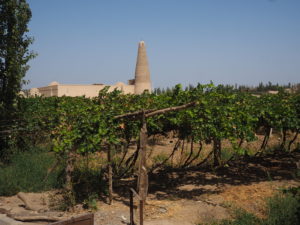
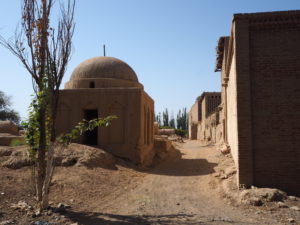
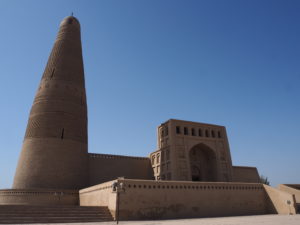
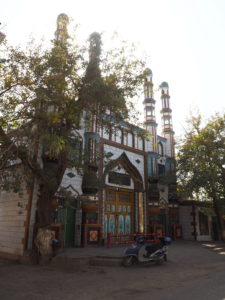
Jiao He Ancient City (交河故城)
We hired a taxi for the day and visited both Jiaohe and Tuyoq for 250rmb, especially good value when you consider Tuyoq is a 100km round trip from Turpan. If you were to use the meter it would cost almost double this. You can hire a taxi off the street or you can arrange one through your hotel or guesthouse which is what we did. The benefit of hiring through a hotel is that they will use a set rate, cheaper than using the meter.
Like a lot of sights in this part of China ticket prices are high, 100rmb per person including a bus to the site itself, 70rmb without the bus. However it is a place that is definitely worth visiting, located on a huge rocky outcrop in between two rivers, this ancient city is one of the most important historical sites in western China today. It is large enough to avoid the tour groups that descend on the site around 11am; the far end of the city itself is usually deserted.
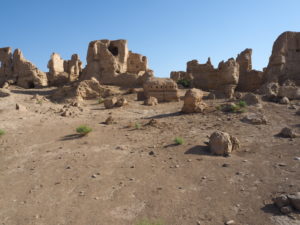
Tuyoq (吐峪沟)
Just under 50 km outside of Turpan hidden away a valley is this grogeous little Uyghur village. On your way you will blast past the distinctly underwhelming flaming mountains (hint driving past is more than enough). Upon entry you will need to go through a security check and add you name, passport number and contact details to the visitor log (incidentally the only place we had to do this in Xinjiang). Once you’ve paid your 30 rmb entrance fee you are free to explore to your hearts content, with the exception of the cemetery just outside of the car park.
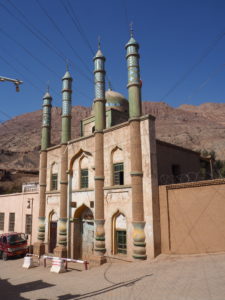
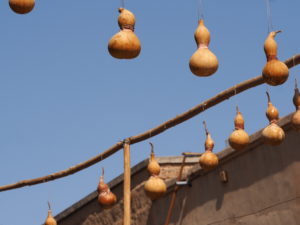
Karakoram Highway – KKH – (中巴友谊路)
Simply put, this is one of the worlds most amazing road trips. Running from Kashgar all the way to the China-Pakistan border close to the Khunjerab pass, which sadly you cannot access without a valid Pakistan visa. The furthest you can go is to the small town of Tashkurgan located approximately 300km from Kashgar.
After crossing into Pakistan the highway continues across northern Pakistan.
We took a lot of amazing photos along the Karakoram Highway (far too many for this article). To check them out click here.
How much time do you need?
There have been blogs and articles from people who have spent over a month traveling along the Karakoram Highway. However the vast majority, us included, do not have this much time. Most people take a 2 day trip, 1 day to Tashkurgan and 1 day back to Kashgar. There are numerous day tours running down as far as Karakul Lake, but this would mean missing out on the best scenery.
The section from Karakul to Tashkurgan is breath taking. I also think Karakul Lake is a little over rated with Baisha Shan and Bulunkul Lake being much prettier by comparison, but obviously it’s each to their own. Also Karakul lake is usually popular with tour groups and to get in to the premium viewpoints its 50rmb a person.
Transport
The easiest and most convenient way to explore the Karakoram Highway is with a private driver. We paid 2600 for our car and driver who we hired through Horizon Travel. Some companies we contacted quoted us 5000rmb. We had to arrange everything in advance as we were leaving from Kashgar the morning we arrived on the night train. Hotels and guesthouses will also be able to arrange such trips. However I cannot comment on what the prices or services entail. During the process of arranging transportation we were given a some contradicting information.
- You must have a guide as well as a driver: 100% false. Some tour companies will insist on having a guide go with you, which of course adds to the fee, however others will allow to just hire a car and driver.
- You have to have a big seven seater car: 100% false. We were told this by a couple of companies, which probably explained their sky high rates. We completed our 2 day trip in a regular 5 door sedan, with no issues from the authorities.
- Foreigners need permits: 100% false. All of the companies we spoke to also confirmed this. However Chinese citizens need to get a special border permit that can be easily obtained at the Public Security Bureau the morning you leave. Be warned, the line is long but it does move very quickly. We were in and out within 30 minutes.
Do be aware that rules can change without warning in China. Do as much research as you can before booking.
Our driver Ali is best contacted through Horizon travel.
Language
Ali did not speak English and from our experience it seems it’s very rare to find a driver that can. Fortunately Ali spoke very good Mandarin meaning we were able to converse without any difficulties. Although I do believe we would have still had an incredible experience regardless of a language barrier.
Accommodation
Options are pretty thin on the ground in Tashkurgan. Most tour companies will book a hotel too, which is usually slightly more expensive than booking it yourself. You will need to consult with the company directly on this regard. Prices range from 300-400rmb per night including breakfast. Sites like booking.com will only show hotels that are legally registered to host foreigners.
What to see and do
There are numerous stunning stops along the Karakoram Highway, so many in fact that we have a separate article showing some of our favourite photos here.
Oytagh Red Mountain Valley
Stunning red mountains flanking a thunderous river with plenty of camels looking on. There are some good hiking opportunities here however it appears that this area is now closed off to foreigners.
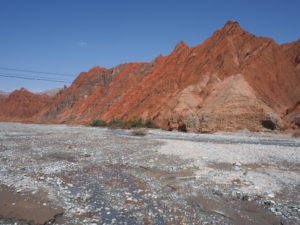
White Sand Mountain/Lake
This particularly stunning lake offers some sublime mountain scenery before you descend towards Karakul.
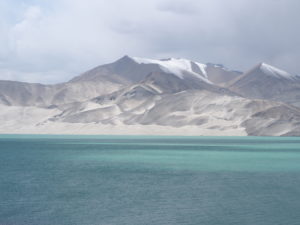
Karakul Lake
One of the most well known destinations on the Karakoram Highway. Expect lots of Chinese tour buses. The best viewing site now costs 50rmb per person. In the past it was possible to stay over night here. However that does not seem to be the case anymore. It’s hyped up by a lot of tour companies and travel guides, however there are plenty of far more stunning places long the highway.
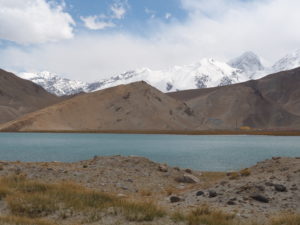
Taheman Grasslands
This section is probably the most stunning of the whole trip. As you descend down towards Tashkurgan.
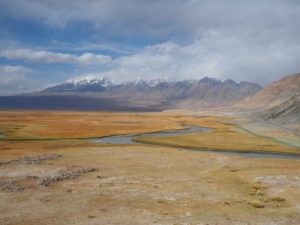
Tashkurgan
With it’s stone fort, grasslands and stunning mountain scenery, Tashkurgan is more than just a place to spend the night.
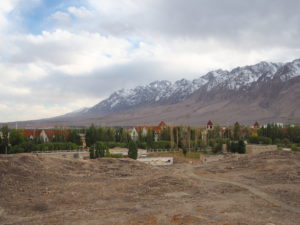
How long does it take?
Expect the journey to take between 7 and 8 hours. Even though its only 300km from Kashgar to Tashkurgan the combination of mountain roads, stops for photographs, and a strict speed limit of 60km means that this journey takes far longer than you would imagine. The speed limit is enforced by a huge network of speed cameras..
Kashgar
For many this is the city that defines Xinjiang. A city that is closer to Baghdad than Beijing. The majority of the population are linguistically, ethnically and culturally closer the Central Asian nations just over the mountains. Although it is very different to the rest of China there are plenty of reminders that you’re still in the middle kingdom.
Kashgar is served by regular flights from Urumqi and even more frequent trains from all over Xinjiang. Kashgar is the end of the line for many long distance trains. Naturally the station, even though it’s small can be quite hectic. Most trains arrive in the morning when it’s still dark (Xinjiang runs on the same time as Beijing, even though it’s timezone is the same as Bishkek which is 2 hours behind). From the station the only way to get into the city is a taxi. Drivers should use the meter, but if they don’t then figure on about 30rmb max. A taxi to or from the airport should be between 30 and 50rmb depending on your negotiating skills.
Getting around Kashgar
The old town is comfortably navigable by foot, however watch out for electric carts whisking Chinese tourists around the maze of narrow alleyways. Outside of this there is a decent bus network that will get your around the city. The only exception is the Sunday livestock market which is serviced by bus 23/24. However it’s a fair old trek from the bus stop, making a taxi a far easier bet.
Where to stay
Simply put, anywhere close to the old town. Everything around the old town is within a comfortable walking distance. C-Trip had numerous good hotel deals when we travelled meaning we were able to get a suite sized room for about 320rmb.
What to do
Kashgar’s Old Town (喀什老城)
With narrow alleys and flower covered walls Kashgar’s old town is a great place to wander for hours on end. Crowds usually gather in the area surrounding the Id Kah mosque. To escape the people head to the south west and north east portions of the town.
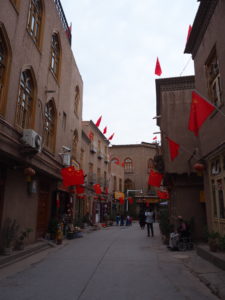
Sunday Livestock Market (喀什牲畜大市场)
Every Sunday traders converge of Kashgar to buy and sell cows, sheep, goats and yaks. It’s certainly an interesting visit, however do bear in mind that this is a working market and as a result you need to keep out of their way. Do be aware of animals that get loose, we saw a couple of bulls get away from their owners with one of them head-butting a guy as he ran past.
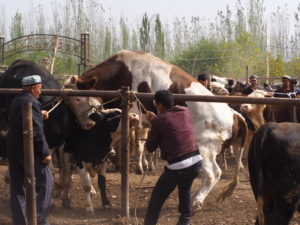
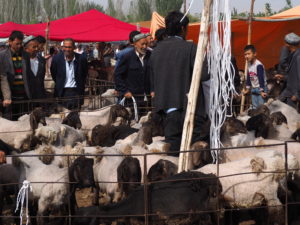
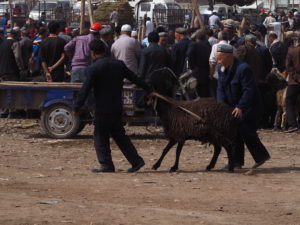
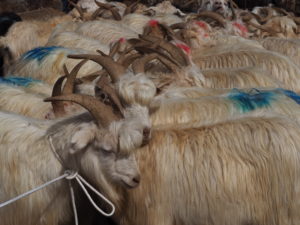
Id Kah Mosque
China’s largest mosque is located in the centre of the old town and is most certainly worth a look around.
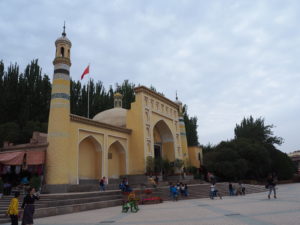
Apak Khoja Mausoleum (香妃幕)
Located around 5km from Kashgar’s old town this gorgeous mausoleum is a lovely place to spend a morning or afternoon. Home to the tombs of 5 generations of Apok Khoja’s family totalling 72 people. However after an earthquake in the 19th century only 58 are still visible. The Chinese name actually translates as “tomb of the fragrant concubine”. This is due to a legend from the time of the emperor Qianlong. After defeating his Uyghur nemesis in battle he became enchanted by his wife and transported her to Beijing where she was to live as one of his concubines. The Chinese version of the story is that she lived out her days happily in the forbidden city. However the Uyghur story has a rather different outcome. Apparently she paced the forbidden city desperately unhappy longing to return to her homeland. When the emperors mother threatened her to resign to her fate or commit suicide she chose the latter. Apparently she is buried in Beijing, although no one is really sure.
To get here take bus 1, 3, 20 or 28. A taxi should cost between 10-15 rmb however buses are pretty frequent and only cost 1 or 2 rmb.
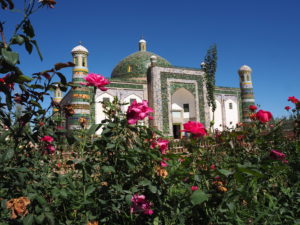
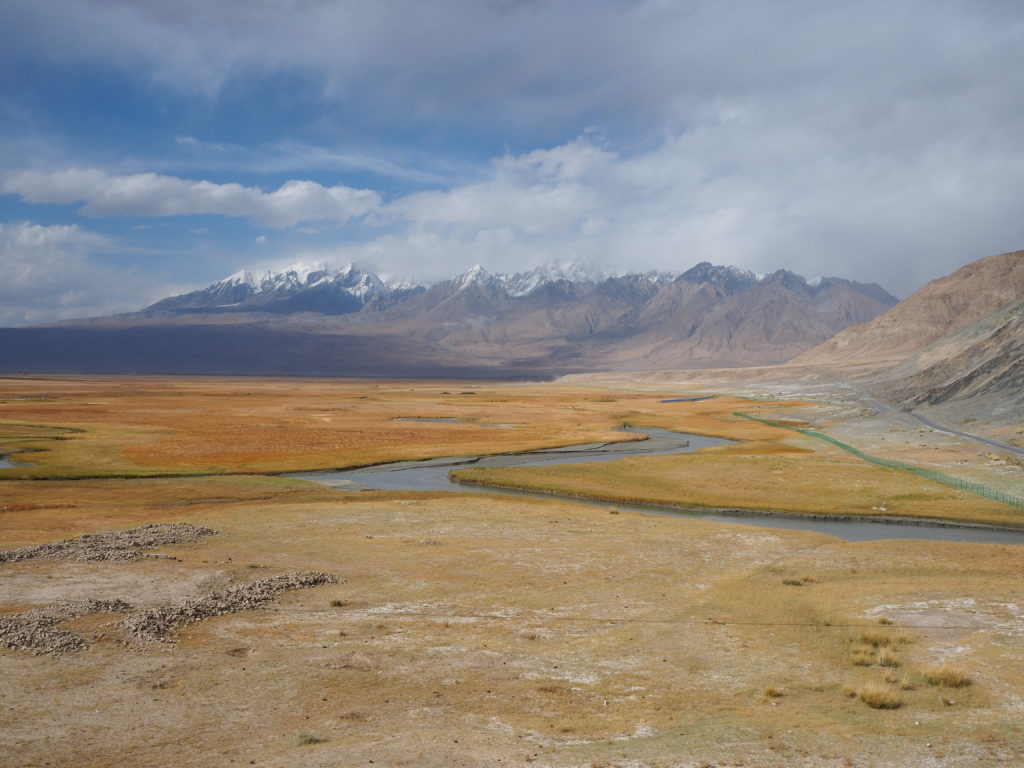
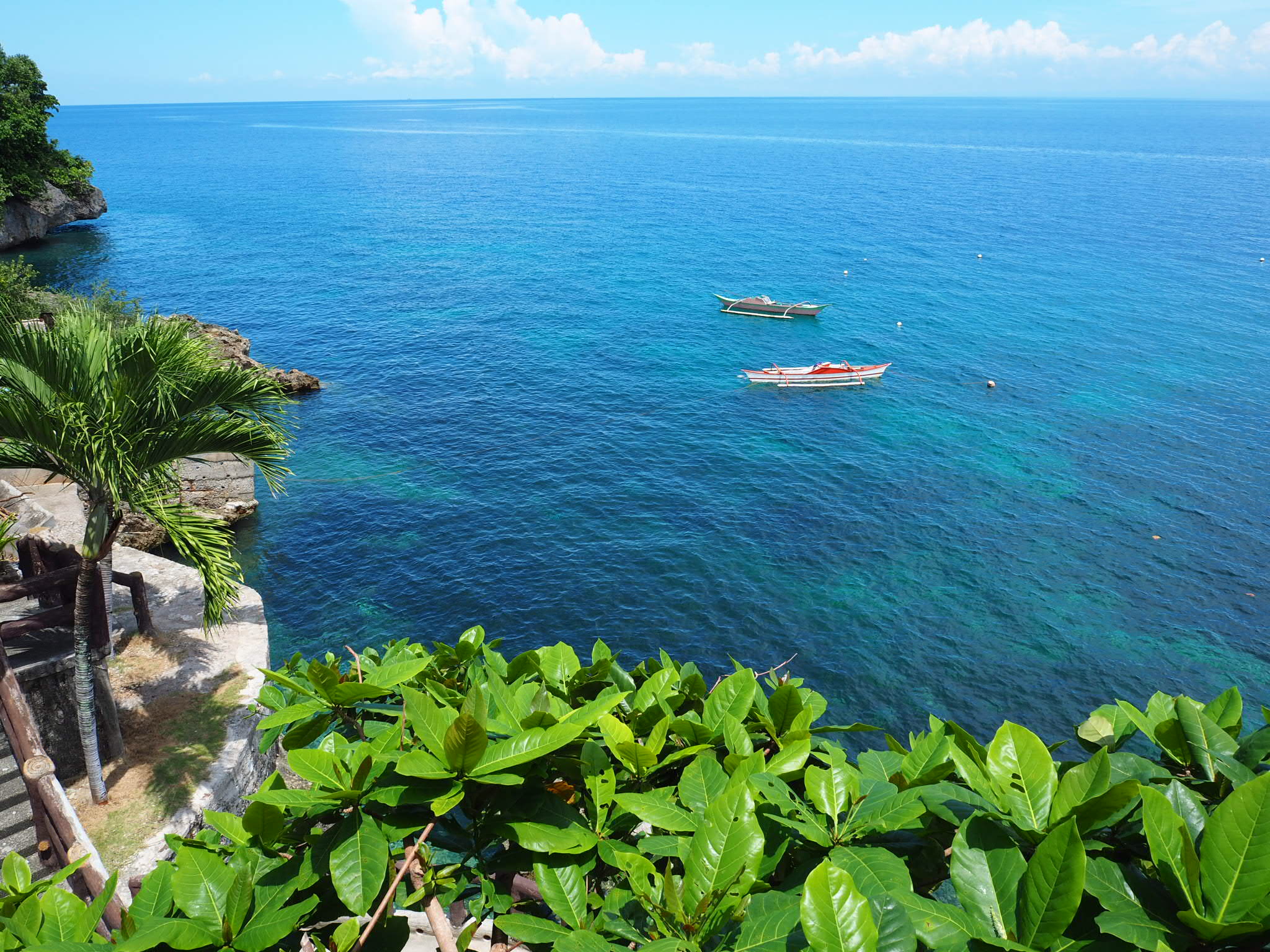
2 Comments
Compared to my other transport experiences in Gansu, Qinghai, Ningxia, and Shaanxi, security checks are far deeper in Xinjiang. Therefore, better to take an additional time margin before your train departure. Lots of ID checks on the road, therefore delaying transportation. Since foreign passports are not automaticaly checked, it is manually double-checked, and causes special delay. Buses had to wait for me. And always keep smiling to the security cams, day and night 😉
From Turpan to Jiaohe, #101 city bus covers part of the distance. Then, taxi, hitch hiking, or walking…
Turpan Museum, quite interesting (even if not competing to the Xinjiang Museum at Urumqi), with lot of explanations on oldest human presences, including mumies (not han related).
From Kashgar railway station, you just need to cross the street to reach the Kashgar Bus Station (useful for transportation to Kyrghyzstan through Wuqia). From there, city bus to Kashgar center, no need for taxis except after 10:00PM Beijing Time.
For the KKH, if you are coming from Pakistan or Tajikistan (through Kulma Pass), you don’t need to charter any service to Kashgar. Regular bus or shared taxis available at Tashkorgan, or hitch-hiking.
At Tashkorgan, the K2 Hostel provides clean dormitories (54 RMB / bed) with very clean bathrooms. Lots of young han students before University return.
Yarkand and Karghilik were no-no for a foreigner, despite very nice special security policemen. Very few hotel hosting foreigners in Hotan, and at a cost. 🙁
Experience early September 2018
Fabrice
The ID checks on the road are a pain. They were checking both my wife, who is Chinese, and myself. The main confusion we had was with my visa being a spousal visa, not a tourist or working visa.